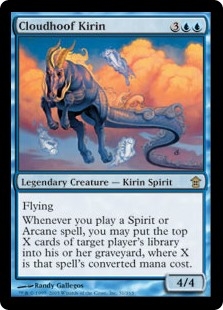 $0.57 @ TCGplayer
$0.57 @ TCGplayer
Flying
Whenever you cast a Spirit or Arcane spell, you may have target player mill X cards, where X is that spell's mana value.
If the Spirit or Arcane spell has {X} in the mana cost, then you use the value of {X} on the stack. For example, Shining Shoal costs {X}{W}{W}. If you choose X = 2, then Shining Shoal’s mana value is 4. Shining Shoal also has an ability that says “You may exile a white card with mana value X from your hand rather than pay Shining Shoal’s mana cost”; if you choose to pay the alternative cost and exile a card with mana value 2, then X is 2 while Shining Shoal is on the stack and its mana value is 4.